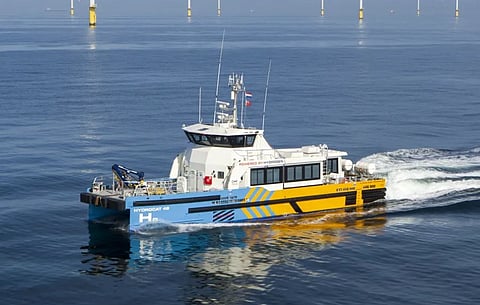

Dutch operator Windcat Workboats and Belgian engineering firm CMB.Tech have unveiled a newly built crewboat that will utilise hydrogen as its main fuel.
The Lloyd's Register-classed Hydrocat 48 has an LOA of 25 metres, a beam of 7.3 metres, a draught of 1.9 metres, and capacity for 10 tonnes of cargo distributed between a 51-square-metre fore deck and an 11-square-metre aft deck. The technology used in the development of the new crewboat was first incorporated by CMB.Tech in a hydrogen-powered passenger shuttle in 2017.
The crewboat is powered by two MAN D2862 LE428 diesel engines that have been modified to run on hydrogen thanks to CMB.Tech's incorporation of a hydrogen injection system, though the engines are designed to easily switch back to diesel if hydrogen is unavailable. The engines have a total rated output of 1,498 kW and drive controllable-pitch propellers to deliver a maximum speed of 31 knots, a service speed of 30 knots, and a bollard push of 12.8 tonnes.
In a form of pre-treatment, a precisely measured quantity of hydrogen is added to the charge air. This mixture of hydrogen and air is then ignited with the injected diesel fuel in the combustion chamber of the cylinders. Depending on the engine's operating point, only a very small amount of diesel fuel is needed.
CMB.Tech said the diesel injection parameters are optimised in dual fuel mode to achieve the lowest emissions as well as optimal consumption values. Therefore, in dual fuel mode, considerably less CO2 is released in the exhaust gases in circumstances where operating behaviour and full load characteristics remain unchanged. In the event of problems in the hydrogen circuit or a depleted hydrogen supply, a switch back to diesel can be made at any time.
Roy Campe, Chief Technology Officer of CMB.Tech, said the suitability of the technology for a crewboat is mainly because existing diesel engines can be used. No fundamental changes to the main engine are required, which not only means that maintenance and repair are kept simple, but also that the engine can easily be switched back to diesel fuel without any modifications.
The long-term plan is to develop the technology and infrastructure to be able to eventually use a mono-fuel option via an internal combustion engine. CMB.Tech expects that the work that went into the new crewboat will lead to the development of fully hydrogen-powered vessels in future.
Hydrocat 48 will sail under the UK flag and will be utilised by Danish offshore wind company Vestas as part of a pilot program to identify how its hydrogen propulsion can help reduce carbon emissions from the latter company's offshore service operations. The testing is being carried out at the Norther offshore wind farm in the Belgian North Sea up to the end of this year.
Vestas said the program will offer the opportunity to explore the most scalable approaches to incorporate hydrogen into the company's operational setup. The goal of the trial will be to collect insights into the opportunities and limitations of hydrogen-powered vessels in daily operations.
| Hydrocat 48 | |
| SPECIFICATIONS | |
| Type of vessel: | Crewboat |
| Classification: | Lloyd's Register |
| Flag: | UK |
| Owner: | Windcat Workboats, Netherlands |
| Operator: | Vestas, Denmark |
| Designer: | CMB.Tech, Belgium |
| Builder: | CMB.Tech, Belgium |
| Length overall: | 25 metres |
| Beam: | 7.3 metres |
| Deadweight tonnage: | 10 |
| Main engines: | 2 x MAN D2862 LE428, each 749 kW |
| Propulsion: | 2 x controllable-pitch propellers |
| Maximum speed: | 31 knots |
| Cruising speed: | 30 knots |
| Types of fuel: | Diesel; hydrogen |
| Operational area: | North Sea, Belgium |
